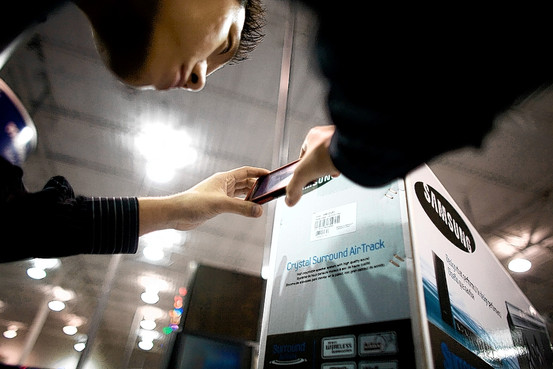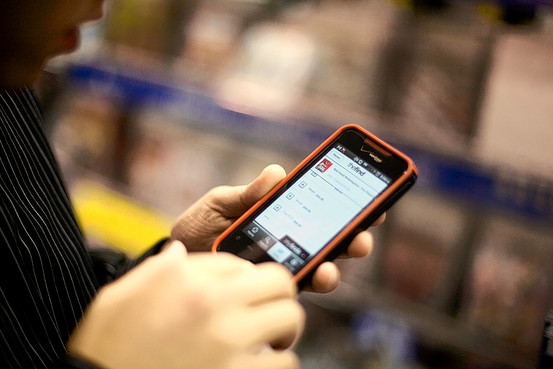Buyers with smartphones have become a nightmare retailers

For buyers in the US, the smartphone has long been a convenient tool for making purchases. And in recent years, buyers use their mobile devices in conventional retail chains. Often, finding the right product in one of the major retail networks, you can scan its barcode using a special application and use one of the Internet services (for example, TheFind) to compare the price of it in different places. So you can easily find the purchase you are interested in a third cheaper and instantly order it from your smartphone.
Buyers really like these opportunities, because they do not have to overpay and they are guaranteed to get the best price. While retail owners see this as a “revolution in retail sales.” Wal-Mart's executive director, Mike Duke, reports on the arrival of a “new era of price transparency,” and believes that this event threatens to reverse the business models of the largest retail chains in America.
Until recently, the main task of retailers was to lure the buyer to the store with special offers, and then try to persuade them to buy a more profitable thing from the seller’s point of view. Now, marketers will have to deal with customers who, using their smart phones in stores, will be able to check how much the price of the “special offer” corresponds to the market, and whether the offer is really profitable.

And such "equipped" buyers more and more. According to IDC Retail Insights, approximately 45% of customers with smartphones already use them to obtain information on product prices.
')
One of the most vulnerable groups of merchants are sellers of branded, expensive things, such as household appliances and electronics. Best Buy, the largest seller of electronics in the United States, said they could lose market share this year due to the trend prevailing due to the widespread use of applications to compare prices.
It remains unclear how many buyers are willing to spend extra time comparing prices. Perhaps consumers will use existing technology only when buying expensive or unusual goods. However, retailers are increasingly concerned about the ability of mobile consumers to shift the balance of power in the retail sector towards consumers, in part because the number of such consumers is increasing. A year ago, during the Christmas sales, the number of customers using mobile devices was only 0.1% of the number of visitors. In the same year, this number increased 50 times to 5.6%.
E-commerce experts expect growth to continue due to growing smartphone sales. At the same time, programmers are busy with developments that turn smartphones into “commercial weapons”. Dozens of mobile apps are available through iTunes and Android Market. For example, the application TheFind was downloaded 400 thousand times in 4 weeks. Many programs allow you to scan barcodes or QR codes or simply speak the name of the product into your device.
And although store managers publicly welcome the “world of transparent prices,” many experts expect countermeasures from stores to use applications to compare prices. Many will have to look for ways to combat the "scourge" in order to survive.
Single stores can afford low prices and perhaps this trend can accelerate the demise of retail chains in its current form.
Since consumers, due to the economic downturn, have begun to choose the cheapest offers they can find, many retail chains cannot charge higher prices in their stores (compensating for the work of the staff and other overhead costs) than on their own websites. Times change. The border between online and offline has become blurred.
Changes in consumer behavior jeopardize some of the most profitable aspects of selling in stores, such as the ability to use sellers to lure shoppers to make impulse purchases. Or the opportunity to induce to buy something else, when a person came completely after another. Some stores try to attract buyers with special offers “goods + gift” or supply certain products with “only with us” price tags in order to force a person to buy goods from them, despite the fact that there are other offers with a lower price.
A study in 10 countries found that 73% of shoppers with mobile phones chose to look into their devices for more information about the product, instead of talking to the seller.
However, although many US retailers are not in a hurry to respond to mobile trends, some of them are beginning to see new opportunities in them. So retailers can divert buyers from competitors' stores. Through partnership with TheFind, BestBuy uses personalized advertising for shoppers when the program discovers that they are on Wal-Mart. Thus, if the buyer at Wal-Mart uses the TheFind application to compare the price of a product, they will receive offers for the same product at Best Buy. And although Best Buy is active in the field of competitors' stores, the network itself refuses to provide information for price comparison services.
More and more consumers are ready to “push a button” to save a couple of dollars. And perhaps the very concept of “visiting one place to buy everything in one fell swoop” can be irretrievably gone.
via The WallStreet Journal
Source: https://habr.com/ru/post/110566/
All Articles